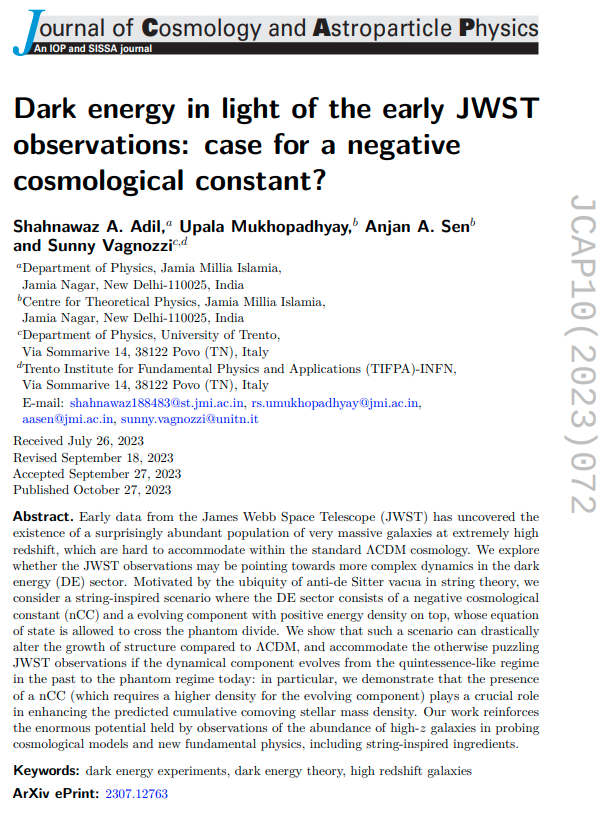My paper with Nicola Menci, Shahnawaz Adil, Upala Mukhopadhyay, and Anjan Sen, where we robustly compare a dark energy model featuring a negative cosmological constant against JWST data (see this earlier news item), has now officially been published in JCAP! The full bibliographic coordinates for the paper are JCAP 2407 (2024) 072. Here is the link to the paper (which is published Open Access).
Negative cosmological constant and JWST paper (part 2) accepted in JCAP!
My paper with with with Nicola Menci, Shahnawaz Adil, Upala Mukhopadhyay, and Anjan Sen, where we robustly compare a dark energy model featuring a negative cosmological constant against JWST data (see this earlier news item), has been accepted for publication in JCAP! The results are basically unchanged compared to our earlier version, with certain aspects of our analysis better clarified. You can read the preprint version of the paper on arXiv: 2401.12659.
Leonardo Comini joins my group!
More members joining my group (and more to come soon)! Today Leonardo Comini has officially begun his Master’s thesis work under my supervision, where he will be studying what a particular class of early JWST observations have to say about ΛCDM. Welcome Leonardo, looking forward to our work together!
Negative cosmological constant and JWST (part 2)
Together with Nicola Menci, Shahnawaz Adil, Upala Mukhopadhyay, and Anjan Sen, today we posted a new preprint which is basically the sequel to our earlier negative cosmological constant and JWST paper published in JCAP. What we did here, in no small part thanks to Nicola’s contribution, was to perform a more thorough analysis of JWST data, which significantly strengthens our earlier conclusions and shows that a dark energy model featuring a negative cosmological constant is a very interesting candidate model in light of the JWST observations. One notable addition was our study not only of photometric observations, but also spectroscopic observations from the FRESCO survey, which again confirm the earlier results and at the same time make them much more robust. It was great fun working on this paper, and I learned a lot about high-redshift galaxies! You can read our results in the preprint we just posted on arXiv: 2401.12659.
Negative cosmological constant and JWST paper published in JCAP!
My paper with Shahnawaz Adil, Upala Mukhopadhyay, and Anjan Sen, studying a dark energy model featuring a negative cosmological constant in light of the JWST observations, which I previously reported on in an earlier news item, has now officially been published in JCAP! The full bibliographic coordinates for the paper are JCAP 2310 (2023) 072. Here is the link to the paper (which is published Open Access).
Negative cosmological constant and JWST paper accepted in JCAP!
My paper with Shahnawaz Adil, Upala Mukhopadhyay, and Anjan Sen, where we show how a dark energy model featuring a negative cosmological constant with an evolving component on top can potentially explain the puzzling JWST observations (see this earlier news item), has been accepted for publication in JCAP! The revision requested was pretty minor, but a notable (and in my opinion rather important) addition is the new Fig. 1 I produced, where we show the effective equation of state of this dark energy model. In some cases it goes through a singularity, which indicates the point where the total energy density of the dark energy switches sign. The singularity is nothing to worry about, as we argued. You can read the preprint version of the paper on arXiv: 2307.12763.
Negative cosmological constant and JWST observations of high-redshift galaxies
Last summer, early observations from the James Webb Space Telescope (JWST) caused quite a stir due to their discovery of a puzzlingly abundant population of extremely massive galaxies at too high redshift, too many to have been in place if the ΛCDM model as we understand it is correct. In today’s new preprint with Shahnawaz Adil, Upala Mukhopadhyay, and Anjan Sen (all three from JMI, and kudos to Shahnawaz and Upala who did all the heavy-lifting!) we study whether these results could be explained by a dark energy model beyond the cosmological constant. In particular we consider a model featuring a negative cosmological constant (anti de Sitter vacuum) with an evolving component (whose energy density is of course positive) on top - this model is phenomenologically motivated from string theory considerations, particularly the swampland program, and the difficulty in constructing consistent de Sitter string vacua. We show that such a model can dramatically alter structure formation and potentially explain how the galaxies seen by JWST could have been in place much earlier than is allowed within ΛCDM. You can read our results in the preprint we just posted on arXiv: 2307.12763.





